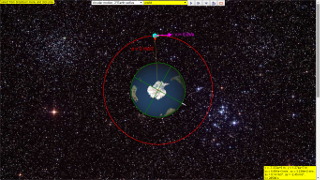About
7.4 Satellite in Circular Orbits
7.4.1 Introduction
An object projected horizontally near the Earth’s surface follows parabolic trajectories as shown ( v = 0 red, v = 2000 green, v = 4000 blue, v = 6000 yellow and v = 8000 teal) .
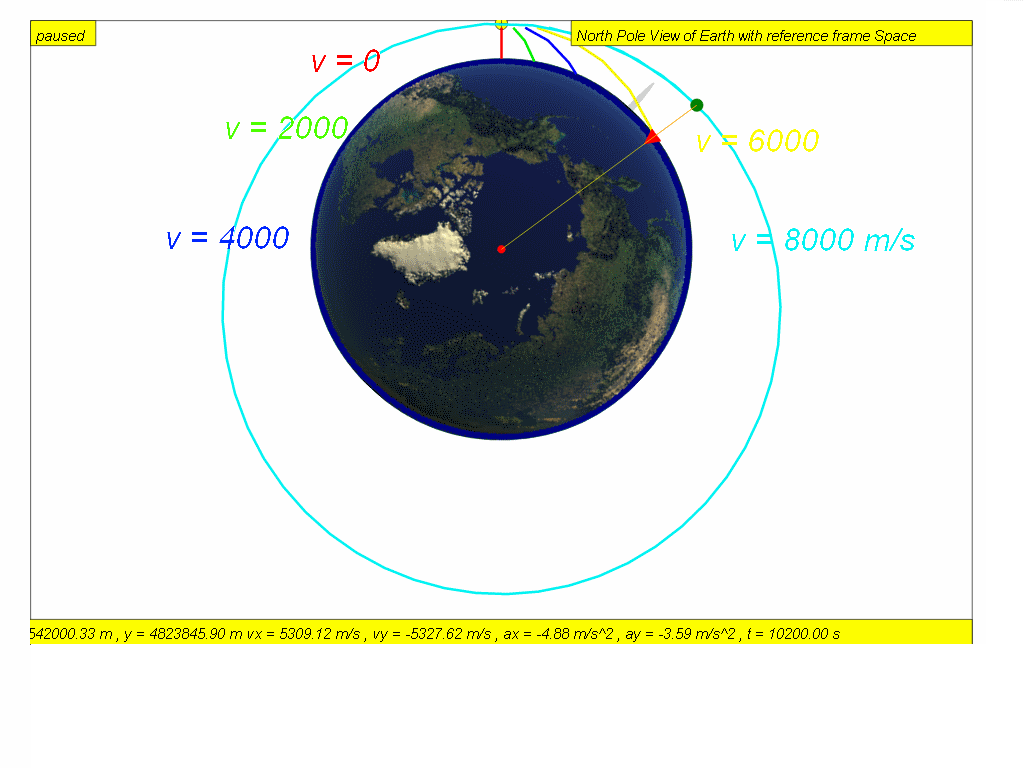
As the speed of projection v increases, the object will reach a speed approximately v = 7888 m/s where the trajectory follows the curvature of the Earth’s surface. [click this for live action now? require internet or scroll down to the model running from hard disk]
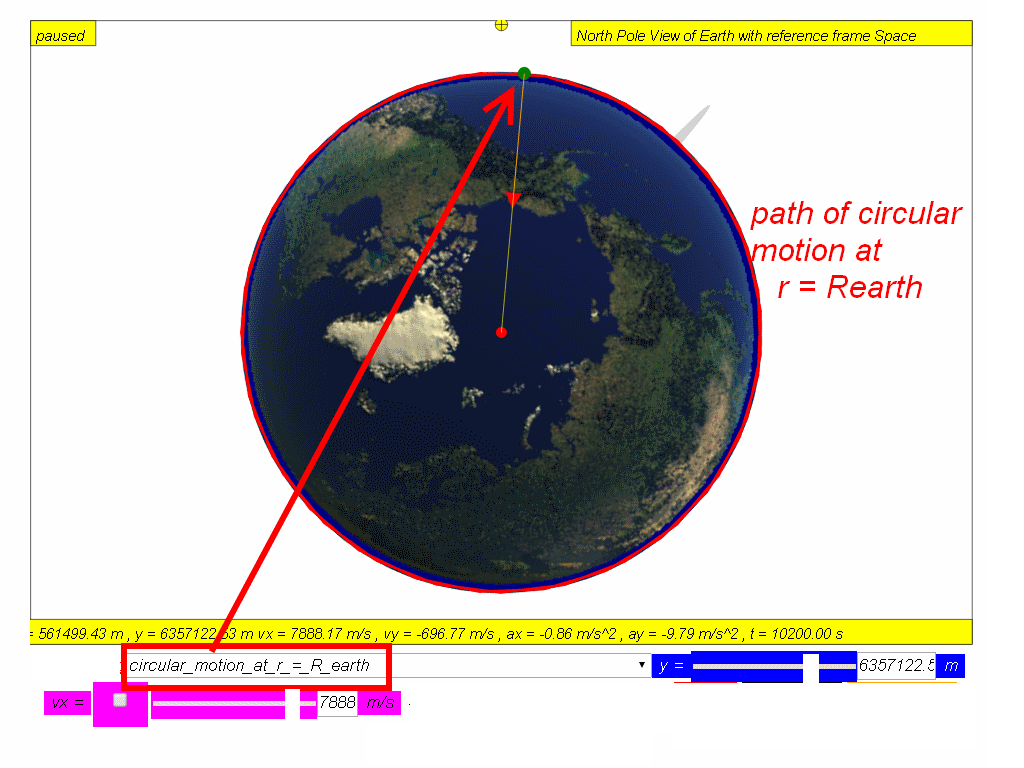
If air resistance is negligible, the object will orbit round the Earth continuously and will never meet the Earth’s surface such as speed v 8000 red m/s and v = 10000 m/s green.
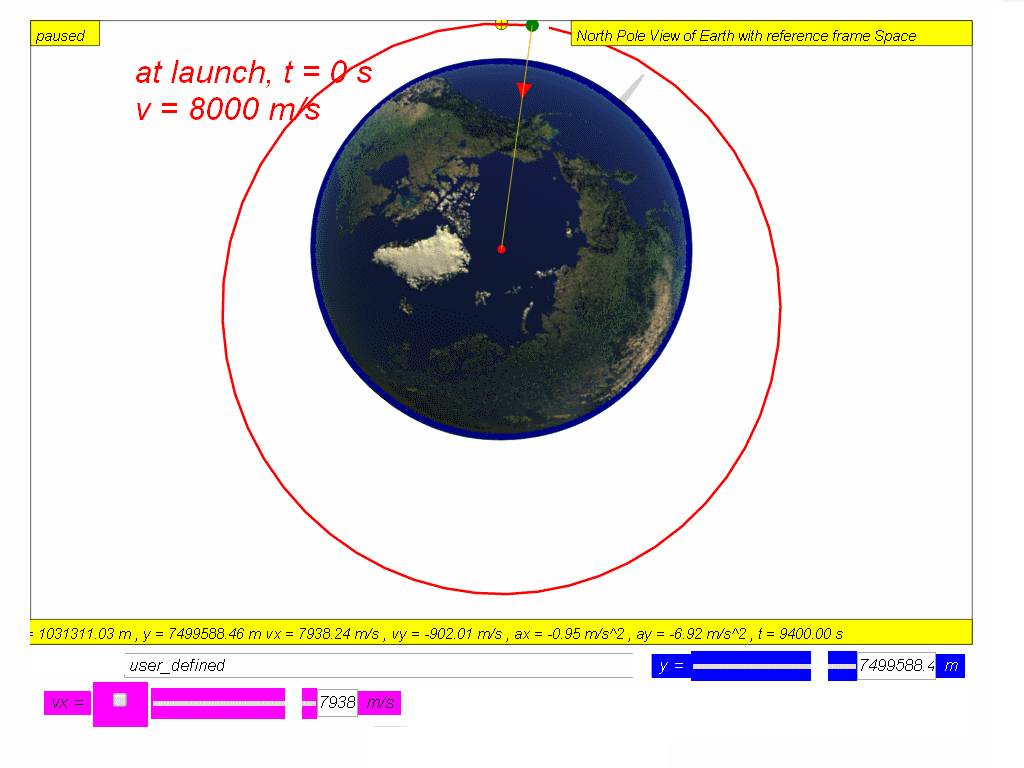

Many man-made satellites move in circular orbits around the Earth. The first man-made satellite, the Sputnik 1, was launched by Soviet Union in 1957. Since then, thousands of satellites have been launched into orbit around the Earth. The only force acting on a satellite in a circular orbit (achieved by launching horizontally at vx =7276.69 m/s at height above Earth surface H = 0.185 RE where RE = 6370 000 m is the radius of Earth, is the Earth’s gravitational force. The gravitational force (red arrow is directed towards the centre of Earth) is also the the centre of the circular orbit.
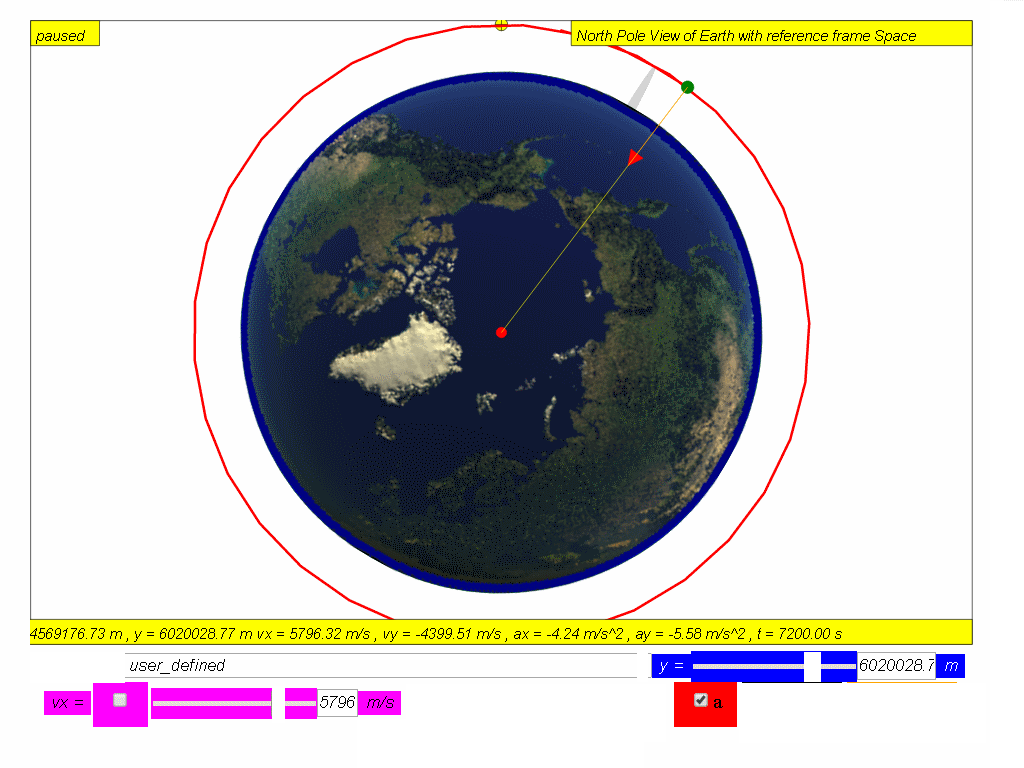
Since the satellite velocity (magenta arrow) is perpendicular to the
gravitational force (Red arrow), its magnitude of velocity remains
constant while its direction changes.
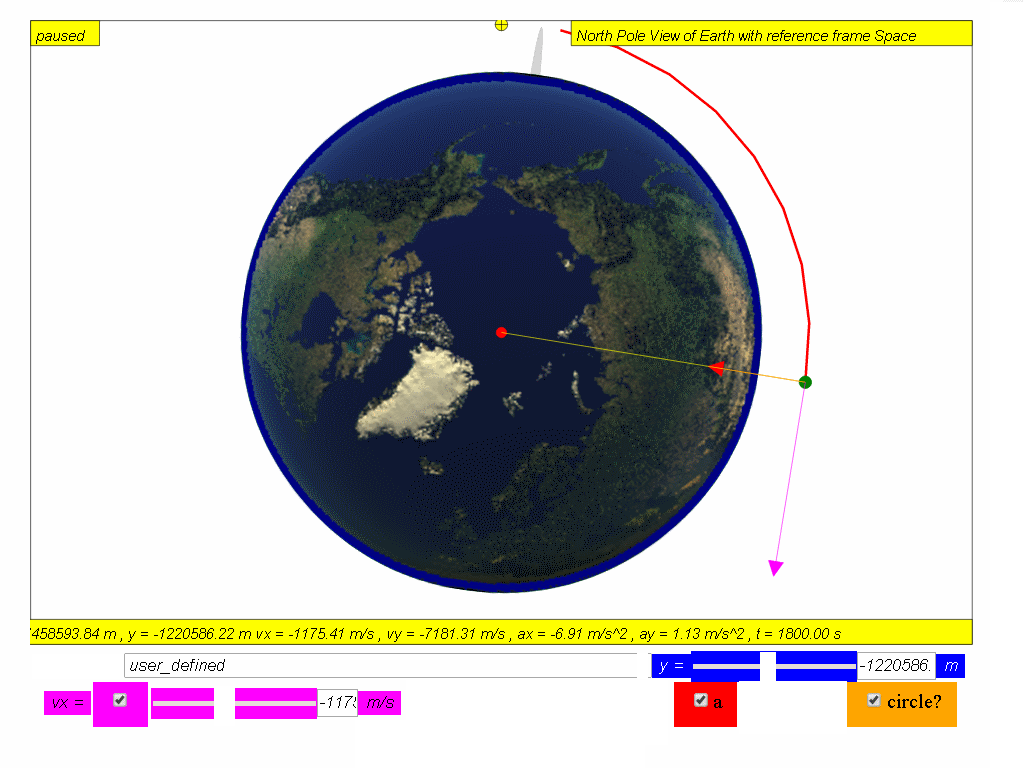
This means that the satellite is traveling in a uniform circular motion
. At the same time, the distance from the satellite to the centre of
Earth will also remain constant in this circular orbit.
For a satellite (or any object) in circular orbit, the gravitational force
acting on it is the centripetal force that keeps it in circular motion.
Using Newton's second law in this context of a circular motion orbit.
Since in outer space, the assumption is only Earth's gravitational field is responsible for the circular motion and gravitational force is
thus,
the expression can be simplified to give the exact velocity required for circular motion .
This equation-formula can be used to calculate the speed required for any object to orbit around a planet of mass M at a constant distance-radius of orbit r
where r is the radius of orbit from the centre of Planet M,M is the mass of Planet M, which is typically Earth.
7.4.2 Inquiry:
What will happen to the orbiting satellite if it starts to slow down? A student says the gravitational force will be higher than the required centripetal force to keep it in the uniform circular motion. Hence the satellite will be pulled closer towards Earth and move in a smaller circular orbit. Explain with evidences from the model whether the answer is satisfactory.
[click this for live action now? require internet or scroll down to the model running from hard disk]
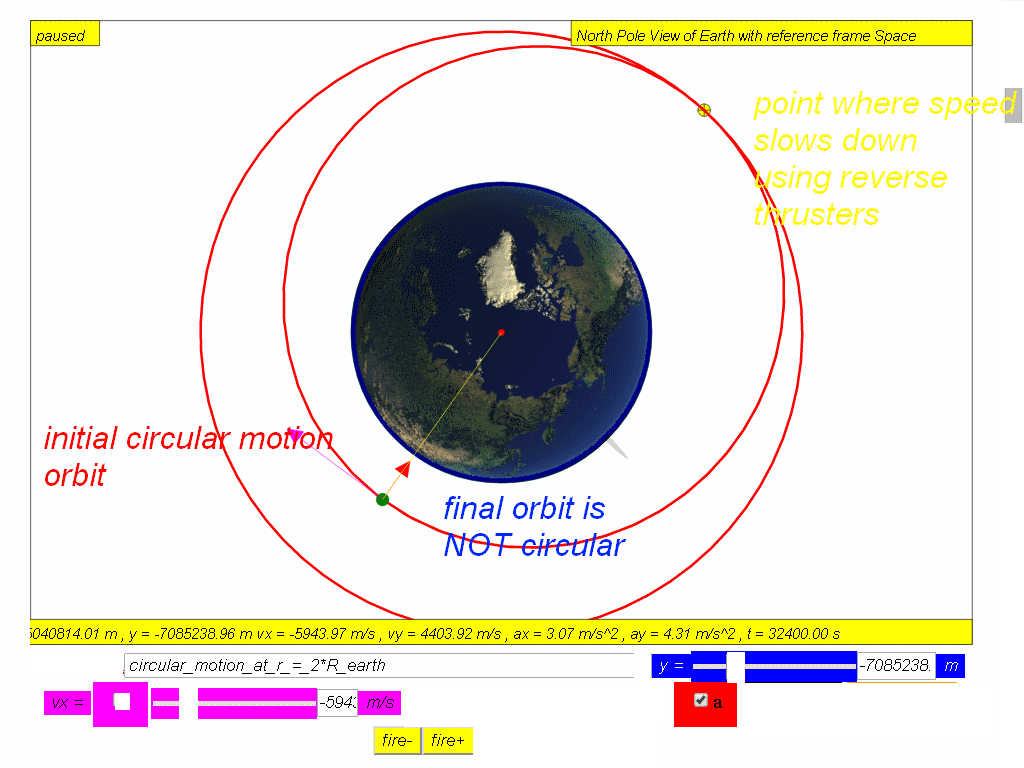
7.4.2.1 Suggested Steps to conduct inquiry
- Select from drop-down menu option circular_motion_at_r_=_2*R_earth
- Click play and observe the motion of the orbit. describe the motion is circular or otherwise.
- Pause the simulation
- Click fire- to simulate firing of reverse thrusters for a very short time, to reduce the speed of the object in orbit.
- Observe the motion of the new orbit. describe the motion is circular or otherwise.
- Design an alternative inquiry option and write down briefly what you have found out.
- Discuss with more classmates in the school and suggest an a community of learners what you have concluded from the evidences collected by at least 3 other independent approach/options.
The desired outcome is to allow the students to experience real orbits are not always perfectly circular (a common misconception for students). Real life orbits are usually elliptical.
7.4.2.2 Calculation of speed at r = 3 times Radius of Earth
Example 10 (Object in orbit)How fast must the satellite be moving in its circular orbit about the Earth, if it stays at a constant height of three times of Earth’s radius, above the Earth’s surface?
(Given: mass of Earth = 6.0 x 1024 kg; radius of Earth = 6.4 x 106 m)
Suggested Steps to solve this problem
- draw a free body diagram of the mass and its path (is it circular,
linear etc?).

- decide on the symbols and values, r = 4(6.4 x 106) = 2.56x107 m
- recall the formula and derive from newton's law
- substitute the values
- imply 3.94x103 m/s = v
- check the answer, put v back to check if still hold for both left and right hand sides of the equal sign.
7.4.2.3 Model
Translations
| Code | Language | Translator | Run | |
|---|---|---|---|---|
 |
||||
Software Requirements
| Android | iOS | Windows | MacOS | |
| with best with | Chrome | Chrome | Chrome | Chrome |
| support full-screen? | Yes. Chrome/Opera No. Firefox/ Samsung Internet | Not yet | Yes | Yes |
| cannot work on | some mobile browser that don't understand JavaScript such as..... | cannot work on Internet Explorer 9 and below |
Credits
![]()

 Todd Timberlake, this remixed version is by lookang (This email address is being protected from spambots. You need JavaScript enabled to view it.); lookang; fu-kwun hwang
Todd Timberlake, this remixed version is by lookang (This email address is being protected from spambots. You need JavaScript enabled to view it.); lookang; fu-kwun hwang
end faq
App
https://play.google.com/store/apps/details?id=com.ionicframework.gravity08app871221&hl=en
Versions:
- http://iwant2study.org/lookangejss/02_newtonianmechanics_7gravity/ejs/ejs_model_NewtonsMountainwee06.jar (older Java version, not updated anymore!, click the download model button just below the picture to get the HTML5 version)
Other resources
- http://physics.weber.edu/schroeder/software/NewtonsCannon.html
- http://www.physicsclassroom.com/Physics-Interactives/Circular-and-Satellite-Motion/Uniform-Circular-Motion/Uniform-Circular-Motion-Interactive
- https://cosci.tw/run/?name=axcSN41469081156263&fbclid=IwAR0WFDGdROUeqVzBGwKuCGGSgfVlaXjKS_iX_OFJWdhyo96M1gTvJELRQg8 Centripetal Force - Sputnik Track & Cycle:
- https://cosci.tw/run/?name=Plr6hg1452128704066&fbclid=IwAR1gm70w9OFG7_4tJnJbm_GBhfN6heqNQTZGZVWdlrDnn6LJd-SyV7H1Do0 Surface Gravity


